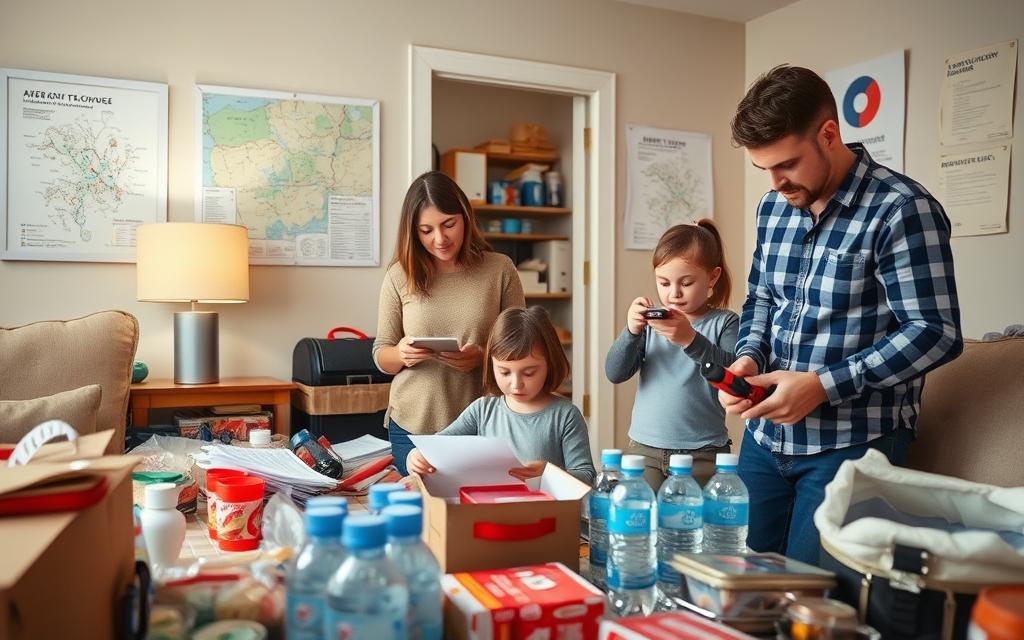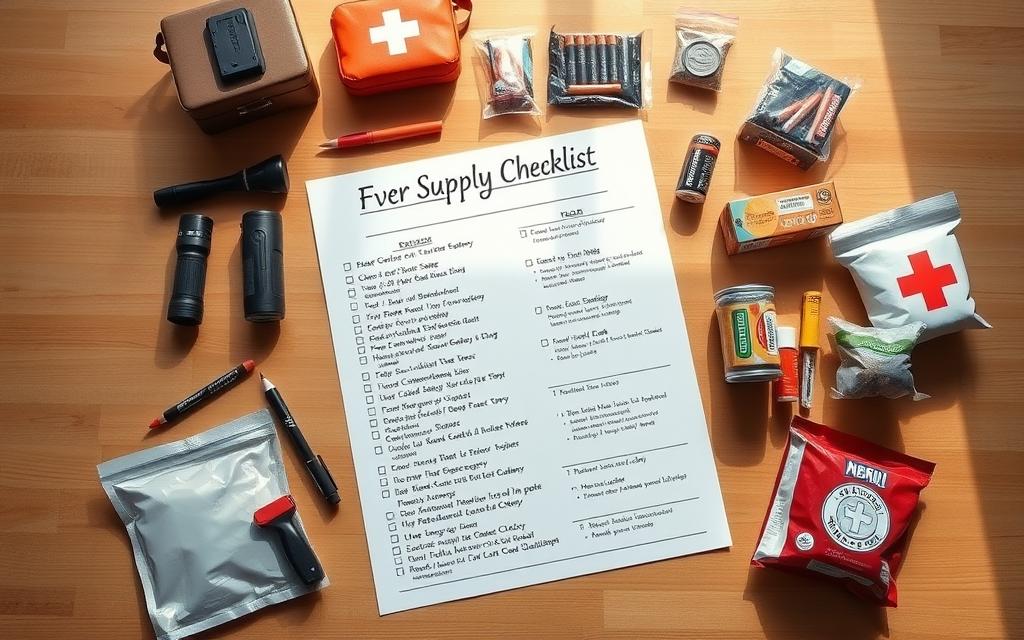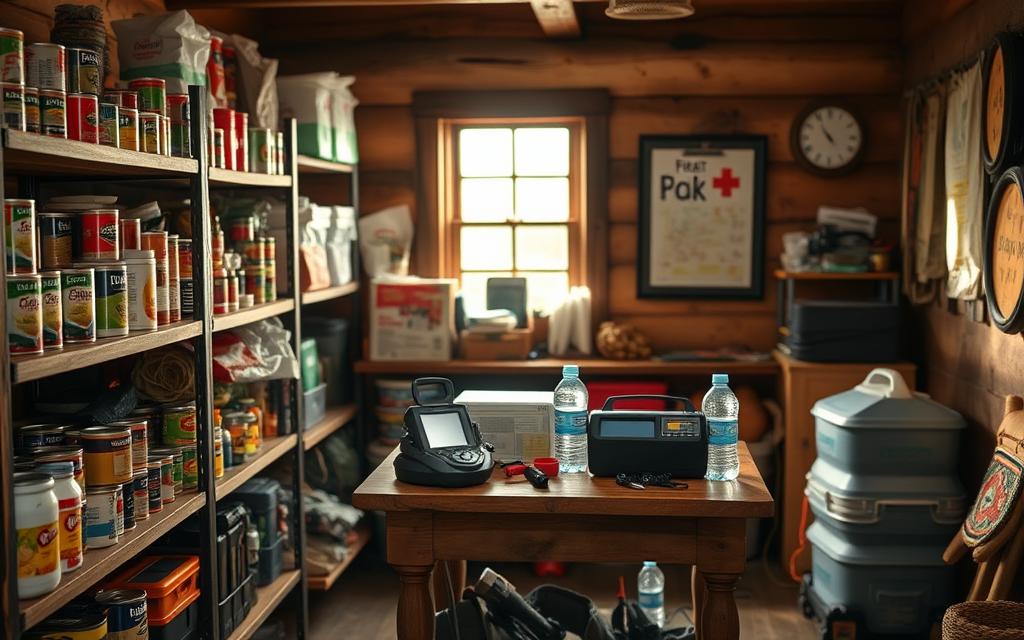When unexpected events strike, having a plan and the right tools can help keep your household safe. A well-organized disaster supplies kit ensures you’re ready to handle disruptions, whether they last hours or days. This guide walks through essentials like water, non-perishable food, and other critical items recommended by experts.
Why focus on a kit? During crises, access to help may be delayed. Storing basics like first-aid supplies, medications, and flashlights in one place reduces stress and speeds up your response. Organizations like FEMA and the American Red Cross emphasize tailoring your kit to your family’s needs—including pets or medical requirements.
Proper storage matters. Keep items in a portable container, like a backpack, and check expiration dates every six months. Designate safe spots in your home and discuss meeting points with loved ones. A little preparation today means confidence tomorrow.
In the sections below, we’ll break down how to build a reliable kit, prioritize must-have items, and maintain readiness for any situation. Let’s get started.
Introduction to Emergency Preparedness
Being ready for sudden crises isn’t just practical—it’s a lifeline for those you care about. Nearly 60% of U.S. adults aren’t fully equipped to handle severe weather or power outages, according to FEMA research. Taking small steps now creates a safety net that keeps your household resilient when systems fail.

Why Immediate Response Matters
First aid supplies transform panic into action during injuries or medical emergencies. A stocked kit with bandages, antiseptics, and medications lets you address burns, cuts, or allergies before professional help arrives. Pair these items with flashlights, batteries, and a weather radio to maintain communication when networks go down.
Security Beyond the Basics
Non-perishable food and water stores prevent hunger during extended disruptions. Keep 3-day supplies for each family member, including pets. Equally vital? Copies of insurance policies, IDs, and medical records in waterproof sleeves. These documents prove ownership and speed up recovery processes after floods or fires.
Storing critical information like emergency contacts and evacuation routes ensures everyone stays informed. Regularly discussing your plan builds confidence—kids learn where to go, adults know how to reconnect if separated. This shared understanding turns chaos into coordinated action when minutes count most.
Building Your Emergency Preparedness Checklist
Creating a reliable safety plan starts with knowing exactly what your family requires. A thoughtful approach combines universal supplies with personalized adjustments. Focus on durability and accessibility—store items in airtight plastic bags to shield them from moisture or pests.

Core Items for Health and Safety
Begin with basics like bandages, antiseptic wipes, and pain relievers for minor injuries. Include prescription medications and backups for chronic conditions. Don’t forget spare batteries for flashlights or medical devices—these often get overlooked until they’re urgently needed.
Pack non-perishable snacks and water purification tablets. Use sturdy plastic containers to organize these supplies by category. Label everything clearly so anyone can find what they need quickly.
Tailoring to Your Unique Situation
Every household has distinct needs. Families with infants require diapers, while pet owners should stash extra food and leashes. Keep a laminated contact list with doctors, relatives, and local shelters. Update it annually or after major life changes.
Review the American Red Cross guidelines for specialized scenarios like allergies or mobility challenges. Add extra aid items like thermal blankets or hearing aid batteries based on your circumstances. This flexibility turns a generic kit into a lifeline built just for you.
Stocking Your Basic and Additional Supplies
A well-stocked kit bridges the gap between chaos and calm during unexpected events. Focus on gathering items that address immediate needs while staying portable. Prioritize durability and accessibility to ensure everything works when it matters most.

Must-Have Items in a Basic Disaster Kit
Start with communication tools like a battery-powered radio or hand-crank model. These devices keep you informed if cell towers fail. Pair them with extra batteries—three sets minimum—to avoid losing critical updates during prolonged outages.
Store essentials in sturdy, waterproof bags or hard-shell cases. This protects items from moisture and makes them easy to grab quickly. Include a three-day supply of non-perishable snacks, water bottles, and a manual can opener.
Families with infants need diapers, formula, and spare bottles. Rotate these every few months to maintain freshness. Pet owners should add food portions, collapsible bowls, and vet records to their supplies kit.
Use airtight plastic bags for smaller items like matches, medications, or first-aid tools. Label each bag clearly so nothing gets overlooked in stressful moments. A little organization now saves precious time later.
Maintaining and Updating Your Emergency Kit
Keeping your safety supplies in top shape requires consistent attention and smart organization. Just like checking smoke alarms, reviewing your kit every six months ensures nothing expires or goes missing. A quick refresh today means fewer worries tomorrow.

Stay Ahead of Expirations
Mark expiration dates for medications, food, and water on your calendar. Replace items like granola bars or antiseptic wipes before they go bad. Rotate one gallon of water per person every three months to keep it fresh and safe to drink.
Don’t forget hygiene essentials. Soap, toothpaste, and hand sanitizer lose effectiveness over time. Store these in sealed bags with duct tape to prevent leaks. Check flashlight batteries and replace any that corrode—rust can ruin your entire kit.
Smart Storage Solutions
Use airtight plastic bins to protect supplies from moisture and pests. Secure lids with heavy-duty tape for extra protection during moves. Label each container by category—hygiene, tools, documents—so you can grab what’s needed fast.
Keep copies of insurance papers and IDs in waterproof sleeves. Update them yearly or after major life changes. Place a three-day supply of pet food or baby formula in separate pouches for easy access.
Set phone reminders to review your kit every spring and fall. Pair this with daylight saving time changes to make it a habit. A little upkeep goes a long way in keeping your household ready.
Implementing the Emergency Preparedness Checklist in Daily Life
Integrating readiness into your daily life means having supplies where you spend time most. Storing essentials in key locations lets you act fast—whether you’re at home, commuting, or working late. Start by building three compact kits designed for specific needs.

Location-Specific Essentials
Your car kit should include jumper cables, blankets, and a portable phone charger. At work, keep snacks, walking shoes, and a flashlight in your desk. Home kits require more detail—think 1 gallon of water per person daily and pet food if needed.
Tailor each place based on who uses it. A shared office? Add extra batteries. Long commutes? Include roadside flares. Update items seasonally—swap sunscreen for hand warmers in winter.
Stay Connected On the Go
Keep your phone charged and save local shelter maps offline. During evacuations, grab your car kit first—it’s your mobile lifeline. Store copies of IDs in waterproof sleeves here too.
Review the American Red Cross guidelines for regional risks. Check supplies every 3 months when you rotate tires or change smoke detector batteries. Small habits create big protection.
Customizing Your Emergency Prep for Local U.S. Risks
Tailoring your safety strategy to regional threats ensures you’re ready for whatever your area throws at you. Coastal towns face hurricanes, while Midwest states brace for tornadoes. Matching your supplies to these risks builds smarter protection.

Regional Adjustments for Maximum Protection
Start by researching common disasters in your state. Flood-prone areas need waterproof tools like sandbags, while wildfire zones require respirator masks. Always include unscented bleach—8 drops purify a gallon of water if supplies run low.
Families with baby members should pack formula, diapers, and pediatric medications. Store these in sealed bags alongside paper copies of birth certificates and shot records. Digital files can crash—physical records stay accessible during power outages.
- Cold climates: Add thermal clothing and hand warmers
- Earthquake zones: Include crowbars and sturdy gloves
- Hurricane areas: Stash plywood for window protection
Update your kit seasonally. Swap summer sunscreen for winter blankets as needed. The Red Cross recommends keeping clothing layers and spare shoes in your car for sudden evacuations. Pair these with multipurpose tools like Swiss Army knives or solar chargers.
Finally, share your plan. Neighbors can pool resources—one household stores extra bleach, another keeps baby items. Community teamwork turns individual prep into collective safety.
Conclusion
True peace of mind comes from being equipped for life’s uncertainties. Building a reliable safety kit means prioritizing clean air filters, masks, and proper sanitation tools like soap and disinfectants. These items protect your family’s health when outside risks threaten indoor spaces.
Keep bank account details, insurance papers, and IDs in waterproof sleeves. This safeguards critical information if floods or storms strike. Pair these with spare hand sanitizer and gloves to maintain hygiene during extended disruptions.
Review your supplies every six months. Swap expired items and adjust for new needs—like adding baby formula or pet food. Store extra sanitation wipes near first-aid kits for quick access.
Small steps today build unshakable confidence tomorrow. By staying organized and proactive, you create a shield that keeps loved ones safe no matter what challenges arise.
